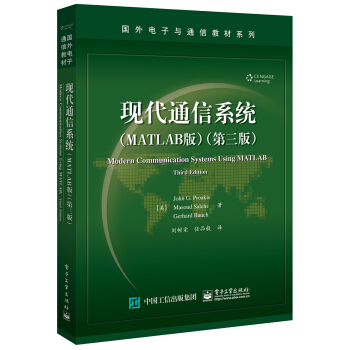![密码编码学与网络安全――原理与实践(第七版)(英文版) [Cryptography and Network Security: Principles and ]](https://pic.tinynews.org/12086237/592eee8bN39c6e718.jpg)

具体描述
编辑推荐
适读人群 :本书适用于高校计算机专业及信息安全专业的高年级本科生和低年级研究生学习,也可作为密码学领域技术人员的参考用书。本书是密码编码学与网络空间安全领域的经典教材,已被国内几十所高校高年级本科生和研究生课程采用为教材。
内容简介
本书系统地介绍了密码编码学与网络安全的基本原理和应用技术。纸质教材分为六部分:背景知识部分介绍计算机与网络安全的概念、数论;对称密码部分讨论古典加密技术、分组加密和数据加密标准、有限域、高级加密标准、分组加密操作、随机位生成和流密码;非对称密码部分讨论公钥加密和RSA、其他公钥加密体制;密码编码数据完整性算法部分讨论哈希函数、消息认证编码、数字签名;互信部分讨论密钥管理与分发、用户鉴别;网络和互联网安全部分讨论网络访问控制和云安全、传输层安全、无线网络安全、电子邮件安全、IP安全。联机内容分为两部分:系统安全部分讨论恶意软件、入侵者、防火墙;法律和道德问题部分讨论与计算机和网络安全相关的法律与道德问题。与第六版相比,书的章节组织基本不变,但增加了许多新内容,如数论、格式保留加密、真随机数生成器、云安全、传输层安全、移动设备安全等。
作者简介
William Stallings:美国圣母大学电子工程学士,麻省理工学院计算机科学博士,《密码术》期刊编委。美国多家高科技公司执行总监,政府机构、计算机软/硬件供应商顾问;曾为各种计算机和操作系统设计并实现TCP/IP和OSI协议套件;创建并维护了计算机科学专业学生资源网站ComputerScienceStudent.com。出版图书17种,内容涉及计算机安全、计算机网络和计算机系统结构等;在《IEEE进展》《ACM计算评论》和《密码术》等杂志上发表文章多篇;先后12次获美国年度*佳计算机科学教科书奖和学术作者协会奖。
William Stallings:美国圣母大学电子工程学士,麻省理工学院计算机科学博士,《密码术》期刊编委。美国多家高科技公司执行总监,政府机构、计算机软/硬件供应商顾问;曾为各种计算机和操作系统设计并实现TCP/IP和OSI协议套件;创建并维护了计算机科学专业学生资源网站ComputerScienceStudent.com。出版图书17种,内容涉及计算机安全、计算机网络和计算机系统结构等;在《IEEE进展》《ACM计算评论》和《密码术》等杂志上发表文章多篇;先后12次获美国年度*佳计算机科学教科书奖和学术作者协会奖。
目录
Part One: Background 1Chapter 1 Computer and Network Security Concepts 1
1.1 Computer Security Concepts 3
1.2 The OSI Security Architecture 8
1.3 Security Attacks 9
1.4 Security Services 11
1.5 Security Mechanisms 14
1.6 Fundamental Security Design Principles 16
1.7 Attack Surfaces and Attack Trees 19
1.8 A Model for Network Security 23
1.9 Standards 25
1.10 Key Terms, Review Questions, and Problems 26
Chapter 2 Introduction to Number Theory 28
2.1 Divisibility and the Division Algorithm 29
2.2 The Euclidean Algorithm 31
2.3 Modular Arithmetic 35
2.4 Prime Numbers 43
2.5 Fermat’s and Euler’s Theorems 46
2.6 Testing for Primality 50
2.7 The Chinese Remainder Theorem 53
2.8 Discrete Logarithms 55
2.9 Key Terms, Review Questions, and Problems 60
Appendix 2A The Meaning of Mod 64
Part Two: Symmetric Ciphers 67
Chapter 3 Classical Encryption Techniques 67
3.1 Symmetric Cipher Model 68
3.2 Substitution Techniques 74
3.3 Transposition Techniques 89
3.4 Rotor Machines 90
3.5 Steganography 92
3.6 Key Terms, Review Questions, and Problems 94
Chapter 4 Block Ciphers and the Data Encryption Standard 100
4.1 Traditional Block Cipher Structure 101
4.2 The Data Encryption Standard 111
4.3 A DES Example 113
4.4 The Strength of DES 116
4.5 Block Cipher Design Principles 117
4.6 Key Terms, Review Questions, and Problems 119
Chapter 5 Finite Fields 123
5.1 Groups 125
5.2 Rings 127
5.3 Fields 128
5.4 Finite Fields of the Form GF(p) 129
5.5 Polynomial Arithmetic 133
5.6 Finite Fields of the Form GF(2n) 139
5.7 Key Terms, Review Questions, and Problems 151
Chapter 6 Advanced Encryption Standard 153
6.1 Finite Field Arithmetic 154
6.2 AES Structure 156
6.3 AES Transformation Functions 161
6.4 AES Key Expansion 172
6.5 An AES Example 175
6.6 AES Implementation 179
6.7 Key Terms, Review Questions, and Problems 184
Appendix 6A Polynomials with Coefficients in GF(28) 185
Chapter 7 Block Cipher Operation 189
7.1 Multiple Encryption and Triple DES 190
7.2 Electronic Codebook 195
7.3 Cipher Block Chaining Mode 198
7.4 Cipher Feedback Mode 200
7.5 Output Feedback Mode 202
7.6 Counter Mode 204
7.7 XTS-AES Mode for Block-Oriented Storage Devices 206
7.8 Format-Preserving Encryption 213
7.9 Key Terms, Review Questions, and Problems 227
Chapter 8 Random Bit Generation and Stream Ciphers 232
8.1 Principles of Pseudorandom Number Generation 234
8.2 Pseudorandom Number Generators 240
8.3 Pseudorandom Number Generation Using a Block Cipher 243
8.4 Stream Ciphers 249
8.5 RC4 251
8.6 True Random Number Generators 253
8.7 Key Terms, Review Questions, and Problems 262
Part Three: Asymmetric Ciphers 265
Chapter 9 Public-Key Cryptography and RSA 265
9.1 Principles of Public-Key Cryptosystems 267
9.2 The RSA Algorithm 276
9.3 Key Terms, Review Questions, and Problems 290
Chapter 10 Other Public-Key Cryptosystems 295
10.1 Diffie-Hellman Key Exchange 296
10.2 Elgamal Cryptographic System 300
10.3 Elliptic Curve Arithmetic 303
10.4 Elliptic Curve Cryptography 312
10.5 Pseudorandom Number Generation Based on an Asymmetric Cipher 316
10.6 Key Terms, Review Questions, and Problems 318
Part Four: Cryptographic Data Integrity Algorithms 321
Chapter 11 Cryptographic Hash Functions 321
11.1 Applications of Cryptographic Hash Functions 323
11.2 Two Simple Hash Functions 328
11.3 Requirements and Security 330
11.4 Hash Functions Based on Cipher Block Chaining 336
11.5 Secure Hash Algorithm (SHA) 337
11.6 SHA-3 347
11.7 Key Terms, Review Questions, and Problems 359
Chapter 12 Message Authentication Codes 363
12.1 Message Authentication Requirements 364
12.2 Message Authentication Functions 365
12.3 Requirements for Message Authentication Codes 373
12.4 Security of MACs 375
12.5 MACs Based on Hash Functions: HMAC 376
12.6 MACs Based on Block Ciphers: DAA and CMAC 381
12.7 Authenticated Encryption: CCM and GCM 384
12.8 Key Wrapping 390
12.9 Pseudorandom Number Generation Using Hash Functions and MACs 395
12.10 Key Terms, Review Questions, and Problems 398
Chapter 13 Digital Signatures 401
13.1 Digital Signatures 403
13.2 Elgamal Digital Signature Scheme 406
13.3 Schnorr Digital Signature Scheme 407
13.4 NIST Digital Signature Algorithm 408
13.5 Elliptic Curve Digital Signature Algorithm 412
13.6 RSA-PSS Digital Signature Algorithm 415
13.7 Key Terms, Review Questions, and Problems 420
Part Five: Mutual Trust 423
Chapter 14 Key Management and Distribution 423
14.1 Symmetric Key Distribution Using Symmetric Encryption 424
14.2 Symmetric Key Distribution Using Asymmetric Encryption 433
14.3 Distribution of Public Keys 436
14.4 X.509 Certificates 441
14.5 Public-Key Infrastructure 449
14.6 Key Terms, Review Questions, and Problems 451
Chapter 15 User Authentication 455
15.1 Remote User-Authentication Principles 456
15.2 Remote User-Authentication Using Symmetric Encryption 460
15.3 Kerberos 464
15.4 Remote User-Authentication Using Asymmetric Encryption 482
15.5 Federated Identity Management 484
15.6 Personal Identity Verification 490
15.7 Key Terms, Review Questions, and Problems 497
Part Six: Network And Internet Security 501
Chapter 16 Network Access Control and Cloud Security 501
16.1 Network Access Control 502
16.2 Extensible Authentication Protocol 505
16.3 IEEE 802.1X Port-Based Network Access Control 509
16.4 Cloud Computing 511
16.5 Cloud Security Risks and Countermeasures 517
16.6 Data Protection in the Cloud 519
16.7 Cloud Security as a Service 523
16.8 Addressing Cloud Computing Security Concerns 526
16.9 Key Terms, Review Questions, and Problems 527
Chapter 17 Transport-Level Security 528
17.1 Web Security Considerations 529
17.2 Transport Layer Security 531
17.3 HTTPS 548
17.4 Secure Shell (SSH) 549
17.5 Key Terms, Review Questions, and Problems 561
Chapter 18 Wireless Network Security 563
18.1 Wireless Security 564
18.2 Mobile Device Security 567
18.3 IEEE 802.11 Wireless LAN Overview 571
18.4 IEEE 802.11i Wireless LAN Security 577
18.5 Key Terms, Review Questions, and Problems 592
Chapter 19 Electronic Mail Security 594
19.1 Internet Mail Architecture 595
19.2 Email Formats 599
19.3 Email Threats and Comprehensive Email Security 607
19.4 S/MIME 609
19.5 Pretty Good Privacy 620
19.6 DNSSEC 621
19.7 DNS-Based Authentication of Named Entities 625
19.8 Sender Policy Framework 627
19.9 DomainKeys Identified Mail 630
19.10 Domain-Based Message Authentication, Reporting, and Conformance 636
19.11 Key Terms, Review Questions, and Problems 641
Chapter 20 IP Security 643
20.1 IP Security Overview 644
20.2 IP Security Policy 650
20.3 Encapsulating Security Payload 655
20.4 Combining Security Associations 663
20.5 Internet Key Exchange 666
20.6 Cryptographic Suites 674
20.7 Key Terms, Review Questions, and Problems 676
APPENDICES 678
Appendix A Projects for Teaching Cryptography and Network Security 678
A.1 Sage Computer Algebra Projects 679
A.2 Hacking Project 680
A.3 Block Cipher Projects 681
A.4 Laboratory Exercises 681
A.5 Research Projects 681
A.6 Programming Projects 682
A.7 Practical Security Assessments 682
A.8 Firewall Projects 683
A.9 Case Studies 683
A.10 Writing Assignments 683
A.11 Reading/Report Assignments 684
A.12 Discussion Topics 684
Appendix B Sage Examples 685
B.1 Linear Algebra and Matrix Functionality 686
B.2 Chapter 2: Number Theory 687
B.3 Chapter 3: Classical Encryption 692
B.4 Chapter 4: Block Ciphers and the Data Encryption Standard 695
B.5 Chapter 5: Basic Concepts in Number Theory and Finite Fields 699
B.6 Chapter 6: Advanced Encryption Standard 706
B.7 Chapter 8: Pseudorandom Number Generation and Stream Ciphers 711
B.8 Chapter 9: Public-Key Cryptography and RSA 713
B.9 Chapter 10: Other Public-Key Cryptosystems 716
B.10 Chapter 11: Cryptographic Hash Functions 721
B.11 Chapter 13: Digital Signatures 723
References 726
Credits 735
Index 736
Online Chapters and Appendices1
Part Seven: System Security
Chapter 21 Malicious Software
21.1 Types of Malicious Software (Malware)
21.2 Advanced Persistent Threat
21.3 Propagation―Infected Content―Viruses
21.4 Propagation―Vulnerability Exploit―Worms
21.5 Propagation―Social Engineering―Spam E-mail, Trojans
21.6 Payload―System Corruption
21.7 Payload―Attack Agent―Zombie, Bots
21.8 Payload―Information Theft―Keyloggers, Phishing, Spyware
21.9 Payload―Stealthing―Backdoors, Rootkits
21.10 Countermeasures
21.11 Distributed Denial of Service Attacks
21.12 References
21.13 Key Terms, Review Questions, and Problems
Chapter 22 Intruders
22.1 Intruders
22.2 Intrusion Detection
22.3 Password Management
22.4 References
22.5 Key Terms, Review Questions, and Problems
Chapter 23 Firewalls
23.1 The Need for Firewalls
23.2 Firewall Characteristics and Access Policy
23.3 Types of Firewalls
23.4 Firewall Basing
23.5 Firewall Location and Configurations
23.6 References
23.7 Key Terms, Review Questions, and Problems
Part EIGHT: Legal And Ethical Issues
Chapter 24 Legal and Ethical Aspects
24.1 Cybercrime and Computer Crime
24.2 Intellectual Property
24.3 Privacy
24.4 Ethical Issues
24.5 Recommended Reading
24.6 References
24.7 Key Terms, Review Questions, and Problems
24.A Information Privacy
Appendix C Sage Exercises
Appendix D Standards and Standard-Setting Organizations
Appendix E Basic Concepts from Linear Algebra
Appendix F Measures of Secrecy and Security
Appendix G Simplified DES
Appendix H Evaluation Criteria for AES
Appendix I Simplified AES
Appendix J The Knapsack Algorithm
Appendix K Proof of the Digital Signature Algorithm
Appendix L TCP/IP and OSI
Appendix M Java Cryptographic APIs
Appendix N MD5 Hash Function
Appendix O Data Compression Using ZIP
Appendix P PGP
Appendix Q The International Reference Alphabet
Appendix R Proof of the RSA Algorithm
Appendix S Data Encryption Standard
Appendix T Kerberos Encryption Techniques
Appendix U Mathematical Basis of the Birthday Attack
Appendix V Evaluation Criteria for SHA-3
Appendix W The Complexity of Algorithms
Appendix X Radix-64 Conversion
Appendix Y The Base Rate Fallacy
Glossary
前言/序言
Preface
In the four years since the sixth edition of this book was published, the field has seen continued innovations and improvements. In this new edition, I try to capture these changes while maintaining a broad and comprehensive coverage of the entire field. To begin this process of revision, the sixth edition of this book was extensively reviewed by a number of professors who teach the subject and by professionals working in the field. The result is that, in many places, the narrative has been clarified and tightened, and illustrations have been improved.
Beyond these refinements to improve pedagogy and user-friendliness, there have been substantive changes throughout the book. Roughly the same chapter organization has been retained, but much of the material has been revised and new material has been added. The most noteworthy changes are as follows:
■■ Fundamental security design principles: Chapter 1 includes a new section discussing the security design principles listed as fundamental by the National Centers of Academic Excellence in Information Assurance/Cyber Defense, which is jointly sponsored by the U.S. National Security Agency and the U.S. Department of Homeland Security.
■■ Attack surfaces and attack trees: Chapter 1 includes a new section describing these two concepts, which are useful in evaluating and classifying security threats.
■■ Number theory coverage: The material on number theory has been consolidated into a single chapter, Chapter 2. This makes for a convenient reference. The relevant portions of Chapter 2 can be assigned as needed.
■■ Finite fields: The chapter on finite fields has been revised and expanded with additional text and new figures to enhance understanding.
■■ Format-preserving encryption: This relatively new mode of encryption is enjoying increasing commercial success. A new section in Chapter 7 covers this method.
■■ Conditioning and health testing for true random number generators: Chapter 8 now provides coverage of these important topics.
■■ User authentication model: Chapter 15 includes a new description of a general model for user authentication, which helps to unify the discussion of the various approaches to user authentication.
■■ Cloud security: The material on cloud security in Chapter 16 has been updated and expanded to reflect its importance and recent developments.
■■ Transport Layer Security (TLS): The treatment of TLS in Chapter 17 has been updated, reorganized to improve clarity, and now includes a discussion of the new TLS version 1.3.
■■ Email Security: Chapter 19 has been completely rewritten to provide a comprehensive and up-to-date discussion of email security. It includes:
—— New: discussion of email threats and a comprehensive approach to email security.
—— New: discussion of STARTTLS, which provides confidentiality and authentication for SMTP.
—— Revised: treatment of S/MIME has been updated to reflect the latest version 3.2.
—— New: discussion of DNSSEC and its role in supporting email security.
—— New: discussion of DNS-based Authentication of Named Entities (DANE) and the use of this approach to enhance security for certificate use in SMTP and S/MIME.
—— New: discussion of Sender Policy Framework (SPF), which is the standardized way for a sending domain to identify and assert the mail senders for a given domain.
—— Revised: discussion of DomainKeys Identified Mail (DKIM) has been revised.
—— New: discussion of Domain-based Message Authentication, Reporting, and Conformance (DMARC) allows email senders to specify policy on how their mail should be handled, the types of reports that receivers can send back, and the frequency those reports should be sent.
It is the purpose of this book to provide a practical survey of both the principles and practice of cryptography and network security. In the first part of the book, the basic issues to be addressed by a network security capability are explored by providing a tutorial and survey of cryptography and network security technology. The latter part of the book deals with the practice of network security: practic
用户评价
还没来得及深入阅读,只是粗略翻看了目录和前言,这本书就给我一种“沉甸甸”的期待感。在信息安全日益重要的今天,拥有一本权威、全面的参考书是必不可少的。我尤其看重它“原理与实践”的定位,这意味着它不仅仅是枯燥的理论堆砌,更是有实际应用指导意义的。我期待书中能够清晰地阐述各种加密算法的数学基础,以及它们背后的逻辑,这样才能真正理解为什么它们能够提供安全保障。同时,对于网络安全的部分,我也希望能够看到对各种安全协议、攻击模型以及防御策略的详细介绍,并且能够结合实际案例进行分析,帮助我理解这些知识在真实世界中的应用。总的来说,这本书给我的第一印象就是专业、深入,是一本值得投入时间和精力去学习的宝藏。
评分这本书给我一种“硬核”知识的感觉,仿佛一本武林秘籍,里面藏着保护信息安全的绝世武功。我从事IT相关工作多年,对网络安全一直怀有浓厚的兴趣,但总觉得在某些深层次的原理上理解得不够透彻。这本书的名字直击痛点——“密码编码学与网络安全”,这恰恰是我希望弥补的知识短板。我非常期待它能把我带入到密码学的奇妙世界,让我理解那些看似神秘的算法是如何工作的,它们又是如何支撑起整个数字世界的信任体系的。同时,我也希望书中能够提供一些关于网络安全实践的指导,例如如何配置防火墙、如何进行安全审计、如何应对数据泄露等等,这些都是我在实际工作中会遇到的挑战。我相信,通过这本书的学习,我一定能对网络安全有更深刻、更全面的认识,从而更好地保护我所负责的系统和数据。
评分这本厚重的书,光是拿在手里就有一种“学究气”扑面而来。我一直在寻找一本能够系统性地梳理信息安全知识体系的书籍,而这本书的题目正是我所追求的。我希望它能像一位经验丰富的导师,带领我一步步走进密码学和网络安全的殿堂。我期待书中能够从最基本的概念讲起,比如对称加密与非对称加密的区别,数字签名与数字证书的作用,然后逐步深入到更复杂的加密算法和安全协议。对于网络安全部分,我更希望它能涵盖从网络层到应用层的各种安全威胁,以及相应的应对措施,例如如何防范DDoS攻击、如何进行身份认证、如何保障数据传输的隐私性等等。我坚信,通过阅读这本书,我一定能够构建起一个扎实的理论基础,并将其转化为解决实际安全问题的能力。
评分初拿到这本书,便被它厚重的体量和一丝不苟的装帧所吸引。这种“大部头”往往意味着内容的扎实和体系的完整,让人在尚未翻开书页之前,就已经对其价值有了初步的判断。我之前接触过一些关于网络安全的零散资料,但总感觉碎片化,缺乏系统性的梳理。而这本书,从书名来看,就承诺了一套完整的“原理与实践”的框架,这正是我所需要的。我希望它能够从最根本的密码学原理入手,层层递进,将各种安全技术和概念有机地联系起来,最终形成一个逻辑清晰、体系完整的知识网络。我尤其关注书中对不同加密算法的对比分析,以及它们在不同应用场景下的优劣势,这对于我理解技术选型的合理性至关重要。此外,对于网络安全方面,我也希望能看到对当前主流攻击手段的深入剖析,以及相应的防御机制的详细介绍,这样才能做到知己知彼,百战不殆。
评分这本书的封面设计就散发着一种严谨而专业的学术气息,沉甸甸的质感,厚实的纸张,都预示着这是一部值得细细品味的鸿篇巨著。虽然我还没有来得及深入翻阅,但仅仅是目录的浏览,就足以让我对它所涵盖的知识深度和广度产生由衷的敬意。从基础的密码学概念,到复杂的公钥基础设施,再到网络安全的最新威胁和防护策略,似乎无所不包。我尤其期待书中关于“原理与实践”部分的详细阐述,毕竟理论的飞跃需要实践的支撑,只有将抽象的算法和协议落到实处,才能真正理解其精髓,并将其应用于解决实际的安全问题。我感觉这本书不仅仅是一本技术手册,更像是一本通往数字世界安全腹地的地图,指引着我在信息爆炸的时代,如何辨别真伪,如何保护自己。我对书中可能包含的案例分析和实际操作指南充满了期待,希望能从中学习到如何构建更安全的网络环境,如何应对日益严峻的网络攻击。
评分有点皱了
评分看看
评分有点皱了
评分有点皱了
评分看看
评分有点皱了
评分有点皱了
评分看看
评分看看
相关图书
本站所有内容均为互联网搜索引擎提供的公开搜索信息,本站不存储任何数据与内容,任何内容与数据均与本站无关,如有需要请联系相关搜索引擎包括但不限于百度,google,bing,sogou 等
© 2025 book.idnshop.cc All Rights Reserved. 静思书屋 版权所有


![儿童少年卫生学(供预防医学类专业用 第8版 配增值)/全国高等学校教材 [Child and Adolescent Health] pdf epub mobi 电子书 下载](https://pic.tinynews.org/12132157/596f0ce5N7445db1b.jpg)






![体验商务英语综合教程1(第二版 附多媒体学习光盘) [Market Leader Elementary Business English Course Book] pdf epub mobi 电子书 下载](https://pic.tinynews.org/12244397/5a951bfaNaa156c55.jpg)
![中国新闻事业史(修订版) [China Press Development] pdf epub mobi 电子书 下载](https://pic.tinynews.org/12245293/5ac96d16Nd7673562.jpg)



![现代企业管理学—理论、技术与方法 [Modern Enterprise Administration] pdf epub mobi 电子书 下载](https://pic.tinynews.org/12287710/5a7c0e8fN282334db.jpg)





